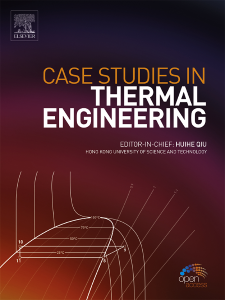Development and characterisation of myristic acid-paraffin wax, silica fume and zinc oxide cementitious composites for thermal control in buildings
IF 6.4
2区 工程技术
Q1 THERMODYNAMICS
引用次数: 0
Abstract
This study focuses on the development of a cement-based phase change material (CBPCM) to improve thermal performance in construction applications. The CBPCM was synthesised by blending 90 wt% of myristic acid with 10 wt% of paraffin wax, absorbed into 10 wt% of silica fume to prevent leakage. Additionally, 5 wt% of zinc oxide was added to improve thermal conductivity. A leakage test conducted with 10 wt% of SF exhibited no signs of leakage during thermal cycling. Scanning electron microscopy (SEM) established the uniform dispersion of the nano-enhanced phase change material (NEPCM) within the cement. Fourier transform infrared spectroscopy (FTIR) analysis revealed no chemical structure changes after 100 thermal cycles. Thermogravimetric analysis (TGA) confirmed thermal stability in the temperature range of 74.8–236.64 °C with a mass loss of 6.3 wt%. The material demonstrated minimal variation in phase change temperatures and latent heats after 100 cycles. The latent heat of the CBPCM was 1.09 J/g during melting and 1.887 J/g during solidification. Incorporating NEPCM into the cement increased the thermal conductivity of the cement matrix to 0.559 W/m K. These findings underline the potential of the CBPCM for energy-efficient construction, offering enhanced thermal storage, stability, and conductivity.
用于建筑物热控的肉豆蔻酸-石蜡、硅灰和氧化锌水泥基复合材料的开发与特性分析
本研究的重点是开发一种水泥基相变材料(CBPCM),以改善建筑应用中的热性能。CBPCM 的合成方法是将 90 wt% 的肉豆蔻酸与 10 wt% 的石蜡混合,并吸收到 10 wt% 的硅灰中以防止泄漏。此外,还添加了 5 wt%的氧化锌以提高导热性。使用 10 wt% 的 SF 进行的泄漏测试表明,在热循环过程中没有泄漏迹象。扫描电子显微镜(SEM)证实了纳米增强相变材料(NEPCM)在水泥中的均匀分散。傅立叶变换红外光谱(FTIR)分析表明,经过 100 次热循环后,化学结构没有发生变化。热重分析 (TGA) 证实了在 74.8-236.64 °C 温度范围内的热稳定性,质量损失为 6.3 wt%。经过 100 次循环后,该材料的相变温度和潜热变化极小。CBPCM 的熔化潜热为 1.09 焦耳/克,凝固潜热为 1.887 焦耳/克。将 NEPCM 掺入水泥中可将水泥基体的导热系数提高到 0.559 W/m K。这些研究结果凸显了 CBPCM 在节能建筑方面的潜力,它可提供更强的热存储、稳定性和导热性。
本文章由计算机程序翻译,如有差异,请以英文原文为准。
求助全文
约1分钟内获得全文
求助全文
来源期刊

Case Studies in Thermal Engineering
Chemical Engineering-Fluid Flow and Transfer Processes
CiteScore
8.60
自引率
11.80%
发文量
812
审稿时长
76 days
期刊介绍:
Case Studies in Thermal Engineering provides a forum for the rapid publication of short, structured Case Studies in Thermal Engineering and related Short Communications. It provides an essential compendium of case studies for researchers and practitioners in the field of thermal engineering and others who are interested in aspects of thermal engineering cases that could affect other engineering processes. The journal not only publishes new and novel case studies, but also provides a forum for the publication of high quality descriptions of classic thermal engineering problems. The scope of the journal includes case studies of thermal engineering problems in components, devices and systems using existing experimental and numerical techniques in the areas of mechanical, aerospace, chemical, medical, thermal management for electronics, heat exchangers, regeneration, solar thermal energy, thermal storage, building energy conservation, and power generation. Case studies of thermal problems in other areas will also be considered.
 求助内容:
求助内容: 应助结果提醒方式:
应助结果提醒方式:


